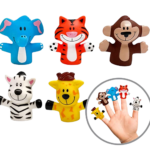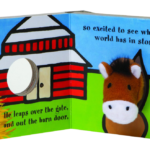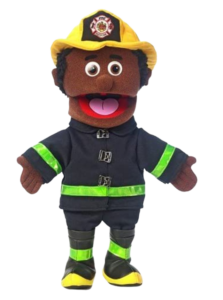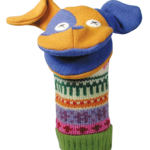Most people understand the basic benefits of paper bags. After all, it would be pretty difficult to bring home groceries without them! However, through the eyes and creative minds of early childhood educators, the benefits of paper bags extend well beyond their ability to hold things, unless you are talking about holding a child’s attention. Paper bags can be turned into puppets that bring with them all of the early childhood development benefits of puppet play, including social-emotional skills, fine motor skills, creativity, and even early literacy skills.
Click, here to check out some of our paper bag puppets that can be used to celebrate all things winter! Plus, if you want to expand your puppet play options, we put together five of our favorites available on Amazon.
5 of Our Favorite Puppets Available on Amazon
1. Ginsey Playtex Bath Finger Puppets

Finger puppets provide all the benefits of social-emotional development, including identifying and expressing emotions, with the added bonus of building fine motor skills in young children. After all, the movement required for puppet play helps with both dexterity and fine motor coordination. We especially appreciate how easy these finger puppets are to sanitize and share!
Teaching Tip: Use these finger puppets as part of a water center or during bathtime. Children will love creating stories with their finger puppet friend and their puppet friend will help children of all abilities stay focused. With older children, encourage them to teach their finger puppets how to wash their face and hands. This builds children’s confidence.
2. Folkmanis Turtleneck Turtle Hand Puppet

Turtles can literally hide in their shells, which makes this puppet especially good for helping children come out of their own shells for when they feel shy or insecure in new situations or surroundings. In addition, children can practice how to be a supportive friend when someone feels shy. A turtle puppet seems naturally created to model positive behaviors for children, such as when it’s time to slow down and sit quietly for storytime.
Teaching Tip: Use this puppet at specific times of the daily routine to help children settle down. In the classroom, maybe this puppet comes out during the beginning of circle time. Turtle can encourage the children to walk at his pace and find a place to sit on the rug. At home, add this turtle to the nightly routine by incorporating him into your storytime. Children will learn to associate this puppet with slowing down.
3. Little Horse Finger Puppet Book

Is it a finger puppet or is it a book? It’s both! With a permanently attached plush horse finger puppet, children and adults can interact and play on every page as they read together. The rhyming story about the horse’s day increases vocabulary acquisition and supports early language development along with the social-emotional benefits puppet play with a caring adult provides.
Teaching Tip: Incorporating puppets into reading together provides additional visual support for young children, including children with autism. Practice turn-taking as you switch control of the horse with each reading.
4. Silly Puppets Fireman Hand Puppet

Fred Rogers inspires us to use puppets to teach children about community helpers, including firefighters. After all, Mr. Rogers brought puppet play mainstream in his Neighborhood and encouraged children to “look for the helpers.” Learning about helpfulness, including when to be a helper, when to ask for help, and who to ask for help, is a key part of social development and gives children practice at learning how they fit within their community.
Tip: Early childhood research shows that how you ask children to help can impact their response. When you ask a preschooler to be “your helper” instead of “to help you,” children are more likely to, well, help. Researchers believe that using the noun “helper” motivates preschoolers because it says something positive about their identity. Children want to be seen as a helper. Try it! Support a young child’s positive identity development by asking a child to be your helper the next time you bring out puppets.

Each puppet is handmade using reclaimed wool. This means that each one offers something beautiful and unique, just like every child. Parents and early childhood educators will have a hard time picking between the more than a dozen animal puppets, including the dog, unicorn, hippo, moose, and even a shark. (The shark is for those who just love singing “Baby Shark” all day.)
Teaching Tip: These mismatched puppets can be the perfect tool for bringing in some silliness to help young children develop their sense of humor. Give your puppet a silly accent or use the puppet to read a familiar book. However, lead the puppet to mess up the words and watch how the children giggle and correct him. This also helps with listening skills as children will lean in to really listen for the puppet “reading” the wrong word.
Do you have a favorite go-to puppet available on Amazon? We found it difficult to narrow it down to our top five. Did we leave off your favorite puppet? Share in the comments below and let us know how you use puppets.
